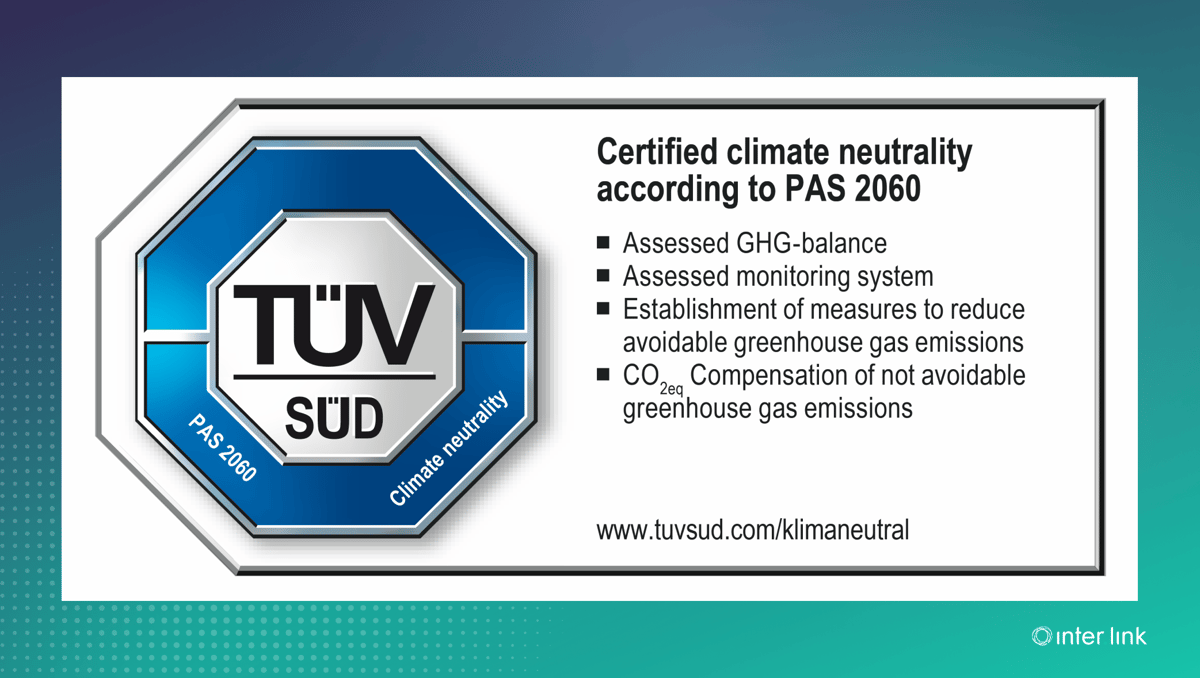Inter.link recently received its 2022 certificate for PAS 2060, an internationally recognised standard for carbon neutrality.
I spoke to Nicol Nógrádi, Special Projects Manager at Inter.link, about how the PAS 2060 certification was achieved, how businesses benefit by meeting sustainability targets early, and first-hand advice for meeting the requirements of a sustainability certification.

THE BUSINESS CASE FOR SUSTAINABILITY
How do businesses benefit from becoming more sustainable?
Aside from the goal of making the planet a better place, meeting sustainability targets earlyalso has multiple business benefits. As mentioned in my interview with Capacity Media,companies are more likely to:
- partner with organisations which have the same values
- get funding if you’re a sustainable business
- attract more employees and customers
Risk mitigation is also a huge factor for becoming more sustainable. Regulations like CSRD already make sustainability reporting compulsory. While this currently only applies to bigger companies with a high number of employees and higher revenue, in a few years this will also be the situation for smaller companies. Additionally, with the European Green Deal, everything is pointing towards more regulations in the future to reach the Green Deal goal.
THE STEPS FOR PAS 2060
What did Inter.link do to achieve the PAS 2060 certification?
The first step was choosing the certification we wanted. We decided on PAS 2060 which was developed by the British Standards Institution, implemented in 2010, and updated in 2014. This certification presents four key stages to carbon neutrality — measurement, reduction, offsetting and documentation.
We chose to implement the standard of PAS 2060:2014 because on top of carbon offsets, it focuses on showing that you are progressively reducing emissions on a year over year basis. In that way, it’s more stringent than other standards. So, we’ve decided to hold ourselves to that higher level.
To be able to certify for PAS 2060, you need to do the following:
- Measure your emissions
We measure emissions across all scopes (Scope 1,2 and 3) with the help of a software called Net Zero Cloud, which helps us to automate the emission mapping process. - Offset your emissions
a.) Through a socially and environmentally beneficial project, we offset our emissions to compensate for our footprint. The aim was to generate biomass-based electricity residues in Tonk, India, which also created additional income flow to local farmers, leading to a total of 550 metric tCO2 certified carbon offsets purchased in accordance with PAS2060 guidelines. This totalled all the calculated operational Scope 1, 2, and 3 emissions of Inter.link.
b.) The offsets were in accordance to guidelines of PAS 2060, and are accredited by Golden Standard
c.) Our offsets are voluntary as we are lawfully not required to do it. - Choose an audit company – In our case it was TÜV SÜD Industrie Service GmbH
- Create a summary – This includes steps taken, priorities for the year and reduction plans about our sustainability initiatives – this is the QES document (Qualifying Explanatory Statement) that we needed to submit to TÜV
- Provide a detailed overview of emissions and records – This was crosschecked randomly to make sure the report aligns with accounting details/invoices
- TÜV does its internal quality check – Then they let you know whether you passed – and Inter.link did!
TOP TIPS BEFORE YOU START
What advice would you give for achieving PAS 2060?
When setting out to achieve a certification, you need to start with measurement of emissions. Then you pick a certification which suits your company’s sustainability goals and realistic capabilities and follow the steps for the standard which you’re applying, making sure you prepare information in advance.
My top four tips for achieving sustainability certifications:
- Expect to be detailed. You need to be able to showcase detailed emissions, need to be able to pinpoint where changes/reductions were made, and need to provide evidence for assumptions that were made during calculation e.g. Type of emission factors used for calculation; type of standard followed e.g. GHG Protocol. Ideally prepared before starting the process.
- Get a handle on QES. You need to draft QES (Quality, Energy, and Sustainability) before starting the audit process – this helps to gain an overview and to speed up the process.
- Start early. The whole process takes long e.g. Several months when you do it the first time, and so it’s worth it to start the process early.
- Get help if needed. If you are not sure about some steps despite reading the requirements, then it can be worth working with external consultants who can help you. Most audit companies are not allowed to give advice on what to do and how to do it; they just check the prepared documents.